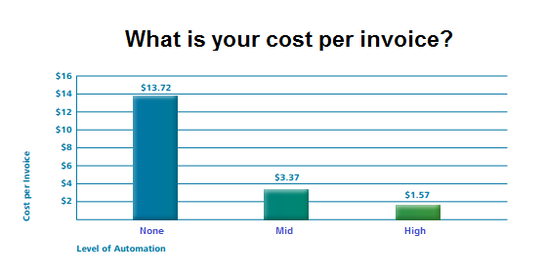
Invoice processes costs vary greatly and are closely linked to the level of accounts payable automation and productivity gains.
The levels of automation shown here are: 1. No automation. 2. Partial automation, such as scanning invoices. 3. Full automation, comprised of scanning and information capture coupled with a business rules engine to enable touchless processing of the majority of invoices as well as integration between the automated process and a company's ERP system. Invoice processing cost comparisons clearly demonstrate how valuable accounts payable automation is to the bottom line of any organization, no matter the size or scale. When a routine job is automated, the resulting efficiencies and cost savings open up learning and development opportunities for staff. The shift caused by automation is one that moves staff from “routine work” to “knowledge work” and this contributes significantly to continuous business improvement and staff job satisfaction. Perceived barriers to automation: With automation shown to be the best route to increased productivity, one might wonder why more organisations have not employed this tool in their accounts payable departments. There are many reasons for this: 1. Within some organizations, internal IT departments can be perceived as a roadblock. Understandably, IT departments handle many requests for various competing projects with limited resources. So it is important to build a compelling business case to ensure your project gains the appropriate support. 2. There is no “one size fits all” software or solution on the market. This can add complexity to the decision-making process but also delivers the benefit of a tailored solution to meet an organization’s existing and future needs. 3. There is a perception that accounts payable automation requires an “all or nothing” approach, which again adds to perceived complexity and effort. In fact automation can take place step by step. 4. Another factor is the fear that suppliers will walk away if you ask them to do something new or different – but in reality this is highly unlikely. 5. Finally, in many organizations, there is a fear of automation – and that it might place jobs at risk. “While automation undoubtedly has a short term effect on particular workers who have grown accustomed to their present habits, it does not show any trend of decreasing the overall size of the economy, or of decreasing the number of jobs available.” When a routine job is automated, the resulting efficiencies and cost savings open up learning and development opportunities for staff. The shift caused by automation is one that moves staff from “routine work” to “knowledge work” and this contributes significantly to continuous business improvement and staff job satisfaction. Courtesy of Accounts Payable Benchmarking Report 2014
0 Comments
Your comment will be posted after it is approved.
Leave a Reply. |
AuthorVision360 Enterprise Accounts Payable Automation Solution by BlueCreek Software reduces time wasted chasing down paper invoices by automating invoice approvals, eliminating manual data entry, eliminating paper invoices and reducing processing costs. Categories
All
Archives
September 2023
|
 RSS Feed
RSS Feed